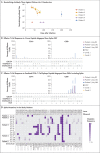SARS-CoV-2 Evolution and Immune Escape in Immunocompromised Patients
- PMID: 35675197
- PMCID: PMC9202319
- DOI: 10.1056/NEJMc2202861
SARS-CoV-2 Evolution and Immune Escape in Immunocompromised Patients
Figures

References
Publication types
MeSH terms
Substances
Grants and funding
LinkOut - more resources
Full Text Sources
Medical
Miscellaneous
